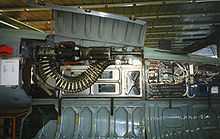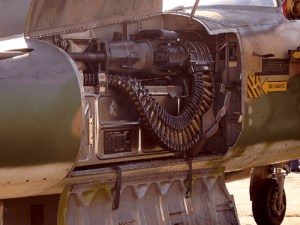M39 cannon
| M39 | |
|---|---|
|
M39 cannon in the nose of a Brazilian F-5. | |
| Type | Single-barrel Autocannon |
| Place of origin | United States |
| Service history | |
| In service | 1952—present |
| Production history | |
| Designer | Ford Motor Company |
| Designed | 1951 |
| Manufacturer | Pontiac, Ford, and others |
| Number built | 35,500+ |
| Variants | M39, M39A1, M39A2, M39A3 |
| Specifications | |
| Weight | 80.9 kg (178.5 lb) |
| Length | 1.83 m |
|
| |
| Caliber | 20 mm (0.787 in) × 102 mm |
| Barrels | Single barrel (progressive RH parabolic twist, 9 grooves) |
| Action | five-chamber revolver |
| Rate of fire | 1,500 rpm |
| Muzzle velocity | 1,030 m/s (3,300 ft/s) |

The M39 cannon was a 20 mm caliber single-barreled revolver cannon developed for the United States Air Force in the late 1940s. It was used on a number of fighter aircraft from the early 1950s through the 1980s.
Development
The M39 was developed by the Springfield Armory, based on the World War II–era design of the German Mauser MG 213, a 20 mm (and 30 mm) cannon developed for the Luftwaffe, which did not see combat use. The same design inspired the 30mm British ADEN cannon and the French DEFA, but American designers chose a smaller 20 mm round to increase the weapon's rate of fire and muzzle velocity at the expense of hitting power. The 20×102mm round was later chosen by France for the M621 cannon.[1]
Initially designated the T-160, the new gun was installed for combat testing on a number of F-86 Sabre aircraft under the "GunVal" program in late 1952, and used in action over Korea in early 1953. It was subsequently adopted as standard armament of the F-86H fighter-bomber, F-100 Super Sabre, F-101A and F-101C Voodoo, and the F-5 Freedom Fighter. Current models of the F-5 Tiger II still use the M39A2 version of this weapon. The M39A2 was introduced in 1964.[2]
The M39 served as the basis for the T75 autocannon developed by the Republic of China (Taiwan), as a more-powerful partial replacement for the M2HB machine gun onboard naval vessels and the HMMWV tactical vehicle, with its latest use being within the XTR-101 and XTR-102 weapon stations.
Projectile specifications
- Projectile weight: 101 g (3.56 oz)
- Types
- M242
- HE-I-T
- M53
- AP-I steel tip has a 50% chance of penetrating 6.3 mm of RHA at a range of 1,000 meters and striking angle of 0º.[4]
- M775
- AP-I-T
- M55A2
- TP
- M220
- TP-T
See also
- List of U.S. Army weapons by supply catalog designation (SNL A-91)
- ADEN cannon—comparable British design
- DEFA cannon—comparable French design
- Mauser BK-27—comparable German design
- M-61 Vulcan—American 20×102mm rotary cannon, replacement of M39; current weapon of most American fighters.
References
- ↑ Jane's Ammunition Handbook, Coulsdon: Jane's Information Group Ltd., 1993, p. 40.
- ↑ Jane's Air Launched Weapons, Coulsdon: Jane's Information Group Ltd., 2000, p. 602.
- ↑ "aircav.com - ammunition: 20mm". Retrieved 2011-07-11.
- ↑ "aircav.com - ammunition: 20mm". Retrieved 2011-07-11.
External links
| ||||||||||||||||||||||
